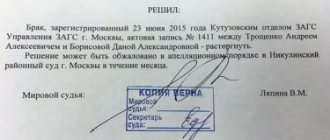Judgment: what is it?
A court decision is a final procedural document that is read by the court after the end of the trial. It expresses the position of the court. A decision using legal norms resolves disputes between the parties to the process (for example, a dispute can be resolved between neighbors on a land plot who have been unsuccessfully conflicting with each other about the boundaries of the plot for many years, or a final point can be made in the division of property of former spouses and the residence of their minor children). In certain cases, a court decision restores the violated right of a party (for example, reinstatement of an illegally dismissed employee at work and recovery of the average wage for forced absence). Sometimes a document eliminates ambiguities in the interpretation of a norm of a legal act applicable to a controversial situation, and interprets incorrectly drawn up clauses of a concluded or existing agreement (the latter is more typical for the arbitration process).
Contents of the decision
Whatever the court decision, it must comply in form and content with the rules prescribed in the procedural codes. The document must contain an introductory, descriptive, motivational and operative part of the court decision. This helps to properly structure the document, dividing it into certain semantic subsections.
1. Introductory part of the solution. It specifies the date of the judicial act, the place of drawing up, the composition of the court and its name, the last name, first name, patronymic of the employee keeping the minutes of the meeting, the name of the parties to the process and the essence of the plaintiff’s stated claims.
2. Descriptive part of the solution. It sets out in detail the essence of the applicant’s demands, the objections of the other side and the explanations of other persons in the case.
3. Motivational part of the decision. It sets out the circumstances, the situation that is being resolved, the evidence provided at the court hearing by the participants in the process and which subsequently forms the basis for the court’s conclusion, references to evidence that the court takes into account and which it considers inappropriate, as well as the legislation that the court applied to a particular case. situations.
4. The operative part of the court decision. This is the most important part of the document. It is in it that the outcome of the statement of claim is stated - whether it is satisfied or the court refuses to satisfy it. It is mandatory to distribute court costs (the winning party is awarded, at the expense of the losing party, compensation for the fees paid, costs and expenses), as well as how the decision can be appealed.
Judgment
A decision is a type of court ruling; it contains the court's responses to claims. The law assumes the presence of the following elements or parts:
- introductory;
- descriptive;
- motivational;
- resolutive.
It is always drawn up in writing and is signed by the judges who considered the case.
The peculiarities of decisions in different forms of legal proceedings should be taken into account. We will consider aspects of civil and arbitration proceedings.
The meaning of the operative part of the decision
As mentioned, the operative part of the court decision is the most important part of the document. It is on the correctness and correctness of the wording prescribed by the court in this part that the ability of the bailiffs to carry out the decision sometimes depends. For example, an error in spelling the name of the defendant from whom the court collected funds makes it difficult to execute the document. And the operative part of the arbitration court’s decision is even stricter, completely, without rephrasing, speculation or changes, transferred to the content of the executive document. It is stated in the form of a short order: to oblige, compensate, collect, etc. For more details on this part of the decision, see below.
What parts does any judicial decision consist of?
The final document of the case consideration by the court includes separately formed sections. The order of their placement is strictly regulated and is not subject to arbitrary adjustments. The judgment consists of four main parts.
The first part is introductory. This should contain information about the time and place of the court hearing, the full name of the authority forming the decision, the composition of the judicial commission (full name of the secretary, prosecutor, representatives and participants), as well as a description of the essence of the proceedings (subject).
The second part is the description. A detailed description of all claims of the participants in the case, a description of the materials, facts and evidence of the case. The requirements of all parties at each stage of consideration are listed. Revisions and changes to final requirements are also reflected in this part.
The third element is the motivation section. This part provides a detailed description of the evidence of the validity of the court decision from the evidence of the case and the legal aspect.
The last part is the resolution . It is carried out in the form of conclusions, requirements and obligations with a concise statement of a list of instructions with clearly defined deadlines for implementation.
The document is drawn up in a strictly business style, without emotional overtones, with the most complete presentation of all aspects of the case, starting from the requirements of the parties and ending with a list of assigned measures and actions as the final verdict.
Structure of a court decision
The operative part of the court decision (sample)
As an example, we take claims, the essence of which is the eviction of the defendants with the provision of other premises.
"The claim is satisfied
Evict Igor Aleksandrovich Neschastlivtsev and Elena Stanislavovna Neschastlivtseva from a three-room apartment located at the address: Neponyatinsk, st. Stroiteley, 78, apt. 17, and provide them with a three-room apartment with a total area of 120 sq. m. m, including a living area of 88 sq. m, which is located at the address: Neponyatinsk, st. Tsvetochnikov, 27, apt. 71."
This is what the operative part of the court decision looks like. The example is fictitious and has no relation to real events and people; it reflects the essence of the decision without indicating the distribution of costs and the procedure for appeal.
What is the operative part of a decision in a civil case? | Moscow
Contact the court with an application for a reasoned decision.
The operative part of a court decision is the part of the court decision that contains the court’s conclusions on the satisfaction of the claim or on the refusal to satisfy the claim in whole or in part, an indication of the distribution of legal costs, the deadline and procedure for appealing the court decision. The operative part of the court decision made by the magistrate must also contain an indication of the deadline and procedure for filing an application for drawing up a reasoned court decision.
Code of Civil Procedure of the Russian Federation Article 199. Drawing up a court decision
(as amended by Federal Law dated March 4, 2013 N 20-FZ)
(see text in the previous edition)
1. The court decision is made immediately after the hearing of the case. The court must announce the operative part of the decision at the same court session in which the trial of the case ended. The announced operative part of the court decision must be signed by all judges and attached to the case. When executing the operative part of the decision in the form of an electronic document, an additional copy of this operative part of the decision is made on paper, which is also attached to the case.
(as amended by Federal Law dated June 23, 2016 N 220-FZ)
(see text in the previous edition)
2. Drawing up a reasoned court decision may be postponed for a period of no more than five days from the date of completion of the trial of the case.
3. The magistrate may not draw up a reasoned court decision on the case considered by him.
4. The magistrate is obliged to draw up a reasoned court decision on the case considered by him if the persons participating in the case or their representatives receive an application for drawing up a reasoned court decision, which can be submitted:
1) within three days from the date of announcement of the operative part of the court decision, if the persons participating in the case and their representatives were present at the court hearing;
2) within fifteen days from the date of announcement of the operative part of the court decision, if the persons participating in the case and their representatives were not present at the court hearing.
5. The magistrate draws up a reasoned court decision within five days from the date of receipt of an application from the persons participating in the case and their representatives to draw up a reasoned court decision.
6. A court decision in a case considered through summary proceedings is drawn up taking into account the features provided for in Article 232.4 of this Code.
(Part 6 introduced by Federal Law dated March 2, 2016 N 45-FZ)
The operative part of the decision in the arbitration process
Disputes arising between legal entities (business entities and other organizations) are resolved by arbitration court. The final document, which logically ends the arbitration process, is almost identical in structure to the decision taken in a civil dispute. It also contains four parts, the most important of which is the operative part of the arbitration court decision. This part is written in imperative form without the argumentation that is found in the motivational part. If the court has established how the decision must be executed, or the decision has taken measures to ensure compliance, then this is also reflected in the operative part of the decision on the claim. Moreover, the legislation provides the court with a five-day period for drawing up the full text of the decision.
The operative part of the court decision, sentence
There are some peculiarities in the names of procedural documents. Thus, the final document adopted by the court of first instance on the merits of the claims is a court decision, set out in the form of a court decision. A resolution is also a document of the court of second instance, which considered the appeal against the decision of the court of first instance; it has the form of an appeal ruling. A resolution is also a document issued by a court of cassation (third) instance. The operative part of the ruling of the third instance court fully reflects the power of the court to cancel, change the rulings of previous courts or leave them in the form in which they were adopted. This applies to documents accepted in disputes that are considered on the basis of the rules of civil procedure.
Regarding the arbitration process, the situation is somewhat different. In it, a resolution is considered a document that is issued by the court of appeal and cassation, having considered a complaint against the final documents of previous courts. The operative part of the court ruling in these cases also reflects the position and powers of the court to uphold court decisions or cancel them due to illegality.
Drawing up the operative part of the arbitration court ruling
The material was prepared by specialists from the Center for Accounting and Taxation Methodology
The organization is considering the possibility of appealing the decision of the arbitration court of appeal and, in this regard, asks for clarification on how the operative part of the decision of the arbitration court of appeal should be drawn up when the operative part of the decision of the first instance court is partially changed. The organization also asks for clarification on how, in this case, the column in the writ of execution should be drawn up, which includes the operative part of the judicial act?
As stated in Part 1 of Article 288 of the Arbitration Procedure Code of the Russian Federation, the grounds for changing or canceling a decision, resolution of the arbitration court of the first and appellate instances are the discrepancy between the court's conclusions contained in the decision, resolution, the actual circumstances of the case, established by the arbitration court of the first and appellate instances, and those available in the case evidence, violation or incorrect application of substantive law or procedural law.
Violation or incorrect application of the rules of procedural law is grounds for changing or canceling a decision or resolution of the arbitration court, if this violation led or could lead to the adoption of an incorrect decision or resolution (Part 3 of Article 288 of the Arbitration Procedure Code of the Russian Federation).
According to Part 1 of Article 271 of the Arbitration Procedure Code of the Russian Federation, based on the results of consideration of the appeal, the arbitration court of the appellate instance adopts a judicial act, called a resolution, which is signed by the judges who considered the case.
Based on paragraph 14 of part 2 of Article 271 of the Arbitration Procedure Code of the Russian Federation, the decision of the arbitration court of appeal must indicate conclusions on the results of consideration of the appeal.
In accordance with Part 1 of Article 319 of the Arbitration Procedure Code of the Russian Federation, a writ of execution on the basis of a judicial act adopted by an arbitration court of the first or appellate instance is issued by the court that adopted the corresponding judicial act.
As stated in paragraph 5 of part 1 of Article 320 of the Arbitration Procedure Code of the Russian Federation, the writ of execution must indicate the operative part of the judicial act.
The Plenum of the Supreme Arbitration Court of the Russian Federation in paragraph 25 of Resolution No. 36 of May 28, 2009 “On the application of the Arbitration Procedural Code of the Russian Federation when considering cases in the arbitration court of appeal” (hereinafter referred to as Resolution No. 36) explained that based on the results of consideration of the appeal filed against part of the decision court of first instance, the appellate court issues a judicial act, in the operative part of which it indicates conclusions regarding the appealed part of the judicial act. Conclusions concerning the unappealed part of the judicial act are not indicated in the operative part of the judicial act.
As stated in paragraph 40 of Resolution No. 36, in the event of a partial cancellation or modification of a judicial act adopted by the court of first instance, a writ of execution is issued by the court of appeal on the basis of a decision based on the results of consideration of the appeal.
Thus, the operative part of the decision of the arbitration court of appeal should contain only conclusions concerning the appealed part of the court decision.
At the same time, when filling out the writ of execution, the arbitration court of appeal must reflect in it both the operative part of its decision and the unchanged operative part of the decision of the first instance court.
Court verdicts and their operative parts
Based on the results of the consideration of a criminal case in which a specific person is accused of committing a criminal offense (for example, having committed murder or theft), the court can pronounce either an acquittal (that is, completely rehabilitate the defendant) or a conviction. Their final parts differ somewhat from each other. Thus, the operative part of a sentence that has the force of acquittal must contain the full last name, first name, patronymic of the person who is being acquitted by the court, an indication that he is considered innocent, the abolition of the preventive measure and ways to eliminate the harm caused, if any.
A conviction differs in form and content from an acquittal. The operative part of a sentence that has the force of an indictment consists of an indication that the defendant is found guilty of a specific crime, indicates what crime he is considered guilty of, the penalty for the crime, the type of correctional institution and other equally important points.
Composition of the court decision, features
The last part is drawn up with special attention, since it is the operative conclusion that is drawn up as a result of a detailed description of the 4 parts of the court decision and is considered the result of the final decision.
The resolution of the court decision includes:
- a diagram of the distribution of costs by stages of the trial, indicating the exact amounts spent on all stages of the process;
- the permissible period and procedure for appealing a decision in case of disagreement of the participants;
- in individual cases, options for deviations from the standard execution of the sentence/decision are described (if this was considered during the trial).
That is, the resolution is the result and final result of the trial.
Legislative definition of resolution
The complaint and its operative part
A complaint differs from court documents in that the complainant (the person filing the complaint) asks the court, government authorities, government bodies or local government to do something. The operative part of the complaint must answer the question of what exactly the complainant or applicant asks or demands.
As a conclusion, we can say that the operative part of the court decision is the result of the final document of the court or complaint.



